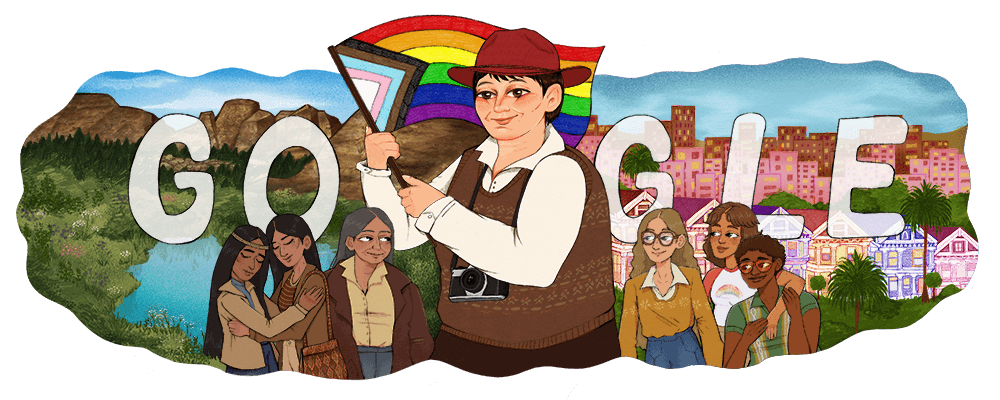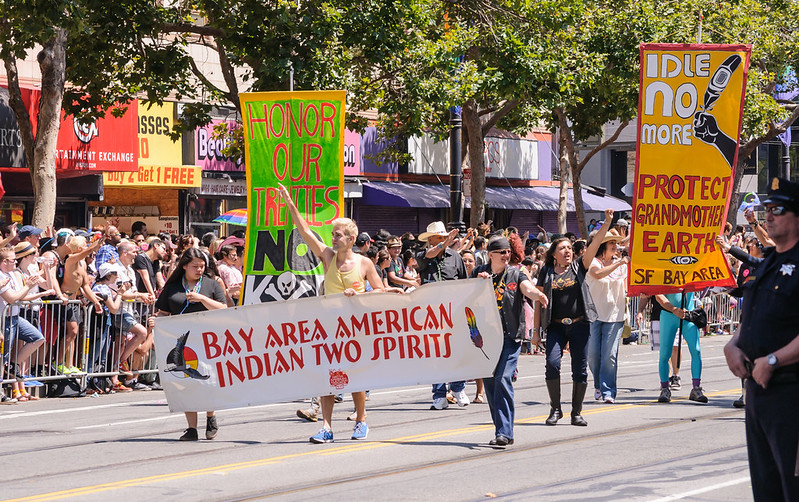First Americans
Related: About this forumA Forgotten Pioneer: The Two-Spirit Activism of Barbara Cameron
(please read the whole story of this amazing, trailblazing person)

The googlel doodle honouring Barbara May Cameron on her birthday, 22 May 1954
A Forgotten Pioneer: The Two-Spirit Activism of Barbara Cameron
3/30/2022 by Gregory D. Smithers
Too often, pioneers like Barbara Cameron—a Hunkpapa Lakota, lesbian, Two-Spirit leader, AIDS activist and social organizer in San Francisco’s Native American community—are forgotten or written out of history.

The term “Two-Spirit” is an umbrella term used to denote Native American people who embody both male and female spirits. It was adopted by gay and lesbian Indians, like Barbara Cameron. (Robert Giard / Copyright Estate of Robert Giard)
Each March, we celebrate pioneering figures in women’s history. We rightly reflect on the accomplishments, insights, and leadership of women such as Harriet Tubman, Susan B. Anthony, Jane Addams and many more. These women changed the course of American history. One such woman who helped change America, but who’s rarely remembered, is Barbara Cameron. Born on May 22, 1954, Cameron grew up on the Standing Rock Sioux Reservation. A Hunkpapa Lakota, Cameron packed a lot into her 47 years—a life of community organizing and activism on behalf of Two-Spirit people.The term “Two-Spirit” is an umbrella term used to denote Native American people who embody both male and female spirits. Adopted by gay and lesbian Indians in 1990, Two-Spirit is an English translation of the Northern Algonquin word niiz manitoag. By adopting the term Two-Spirit, gay and lesbian leaders in Native American communities underscored their determination to make their fight against the twin prejudices of homophobia and racism visible to Native and non-Native Americans.
Barbara Cameron embraced this new term as a way to introduce Two-Spirit people to all Americans. But who was Barbara Cameron?
Cameron was a lesbian, an identity she described as “like a graceful but studied ballet.” She was raised by her grandparents and taught from an early age that she was “special.” Cameron certainly recalled feeling “different” as a child, which meant that the positive reinforcement that her grandparents provided was a welcome boost to her still developing sense of selfhood. Cameron’s self-confidence was also helped by the fact that she was a promising student. “My grandparents always told me I could do anything I wanted or be anything I wanted,” Cameron later recalled. If her grandparents nurtured her, Cameron identified a role model in Beatrice Medicine, an anthropologist and Sihasapa and Minneconjou Lakota, whom Cameron strove to emulate.

Bay Area American Indian Two Spirits at San Francisco Pride in 2013. In the 1970s, racism within San Francisco’s gay and lesbian community meant that LGBTQ Native Americans had few cultural outlets and limited social resources to call on—so, they created their own. (Scarlet Sappho / Flickr)
. . . .
Barbara Cameron dedicated her life to this message. In remembering the Phil Tingley’s legacy, she built on the knowledge he’d shared with her and which she in turn shared with her community. Importantly, Cameron wasn’t alone; there were other Two-Spirit pioneers in the 1990s. She shared the burden of leadership with people like Randy Burns, Clyde Hall, Stephen Barrios, Richard LaFortune, Janet Spotted Eagle, and many others who worked in San Francisco and in Two-Spirit communities across North America.
Cameron’s life ended suddenly in 2002, aged just 47. At her memorial service, Tom Ammiano, San Francisco Board of Supervisors president, remembered Cameron’s “fine qualities of heart and mind.” Cameron used these qualities to make life better for Two-Spirit people, to champion for the rights of those afflicted with AIDS, and to care for women impacted by violence. Today, it’s worth reflecting on pioneering Two-Spirit leaders like Barbara Cameron. At an Elders panel organized to celebrate this year’s BAAITS powwow, the Southern Cheyenne Elder Marlin Fixico spoke movingly about how he is part of the “first generation of Two-Spirit Elders.” Of course, tribal communities across North America have long had specific traditions and titles to refer to people with fluid gender and sexual identities, but Fixico is right: He is part of the first generation of Elders to self-consciously nurture Two-Spirit identities and communities. It is a generation that builds on the life and legacy of Barbara Cameron.
https://msmagazine.com/2022/03/30/two-spirit-barbara-cameron-native-womens-history/